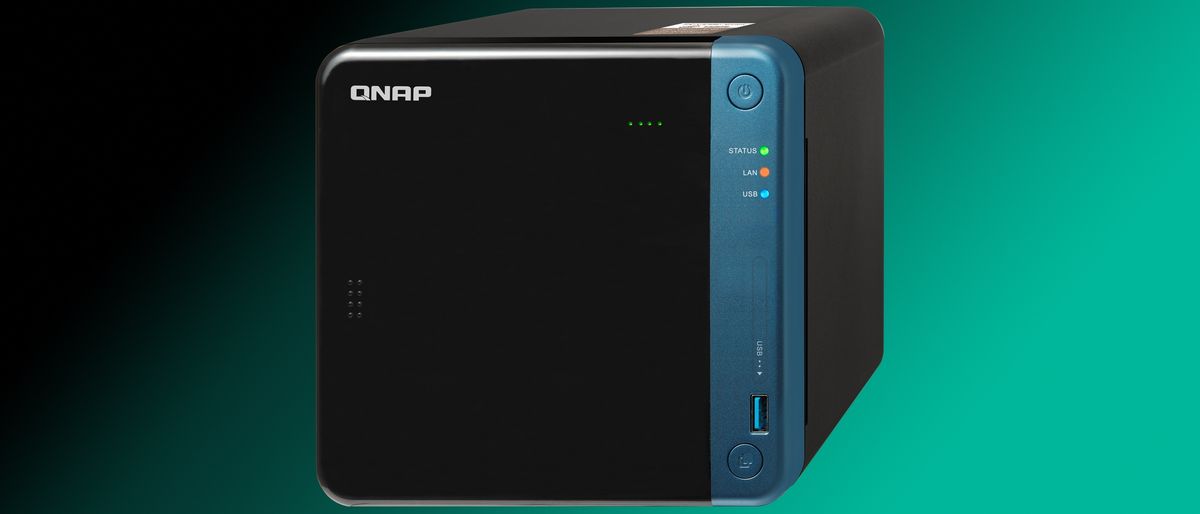TechRadar Verdict
The compact TS-453Be is perfect for home users craving multimedia NAS functionality, but it can also be expanded with a variety of add-in PCIe cards for improved performance and future proofing.
Pros
- +
Dual HDMI and excellent media functionality
- +
PCIe slot and multiple card upgrades available
- +
Can run virtual machines
Cons
- -
Setup can be finicky
- -
Hardware upgrades are expensive
- -
Remote not included
Why you can trust TechRadar
QNAP’s new TS-453Be is a home and small office focused four-bay NAS box which focuses on offering great multimedia functionality, and additionally provides a PCIe expansion slot that lets you install a range of optional upgrades.
The 453Be is essentially the 2018 update to the excellent (though expensive) TS-453B, which originally launched in 2017. This newer version has slightly reduced specs and fewer included accessories, but it's also a lot more budget conscious. That’s a good thing too, as there a bit of a gap has recently developed in the NAS market, with more-affordable NAS options at one end and models aimed at power users at the other, with very little in between.
As is increasing common with today's NAS boxes – even inexpensive ones – the TS-453Be is essentially a mini computer running a custom OS. Not only can it run a huge range of different programs and services (including virtual machines), it has HDMI outputs to plug in an external monitor or TV and can even handle having a keyboard and mouse attached.
The TS-453Be is also more future-proof than most other four-bay NAS boxes thanks to that aforementioned PCIe slot, which supports a range of upgrade cards, such as 10 Gigabit Ethernet. This is an important aspect too, as with quality hard drives, a NAS can be reasonably expected to give five or more years of service without becoming unacceptably out of date.
The TS-453Be is still essentially a high-end NAS at heart, and will therefore appeal to those who can get the most out of it’s versatile feature set.
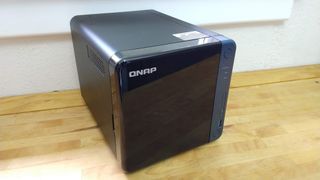
QNAP TS-453Be price & availability
The TS-453Be comes in two different configurations. The more expensive version includes 4GB of RAM, and will set you back $520/£515/AU$750.
If you opt for the cheaper 2GB version, it will cost $500/£466/AU$630 – and to add a little perspective, buying 8GB of RAM that's suitable for the TS-453Be will cost you around $50/£44/AU$89.
The NAS also has a number of QNAP-made add in cards for sale. Read on for more information about the different options, but for now, here are the prices.
The dual M.2 SATA SSD expansion card has the product code QM2-2S, and will set you back $99/£88/AU$130.
The single port 10GbE network card has the catchy moniker LAN-10G1TA, and costs $90/£125 in the US and UK respectively. (That card's not currently available in Australia, with the QXG-10G1T filling the same gap; it costs AU1$60.) There's also a dual-port version of this card on offer – the LAN 10G2SF-MLX – which costs $235/£206/AU$295.
The USB 3.1 expansion card is called the USB-U31A2P01, and at the time of writing, is only available in Australia, for AU$79.
Finally, there's also an 802.11ac Wi-Fi card available – the QNAP QWA-AC2600. It’s not a cheap option though, and you might be better off just buying a wireless access point and adding it to your network unless you absolutely need to connect directly to the NAS. You won’t yet find the card for sale in the UK, but in the US and Australia it costs $150 and AU$215 respectively.
Design & features
At its core, the TS-453Be has a grunty quad-core Intel Celeron J3455 CPU, which can boost to speeds up to 2.3GHz. The CPU includes Intel graphics, and the NAS has dual HDMI 1.4b ports around the back. The TS-453e has two Gigabit LAN ports built in plus five USB 3.0 connections for attaching external devices, including one up front. For easy thumb drive backups, it also has a dedicated USB copy button.
The TS-453Be can also handle up to 8GB of DDR3L RAM across two slots, and is sold with either 2GB of 4GB pre-installed. It will depend on local pricing, but buying the cheaper 2GB version and upgrading the RAM yourself could save you a nice bit of cash. Some retailers are selling the 4GB model for only a little more than the 2GB – if you can find one of those, then that's an OK option, then you can upgrade the RAM in a few years if desired. Actually adding in RAM is easy – just remove the hard drive caddies and the RAM slots are exposed underneath, meaning there's no need to even unscrew anything.
Inside, the NAS had four hot-swappable tool-less drive bays for either 3.5-inch or 2.5-inch SATA drives.
The TS-453Be's real standout feature is its PCIe x2 slot, which allows the NAS to be upgraded with add-in cards, such as a 10GbE network card, M.2 SSD, or 802.11ac Wi-Fi. This has helped to reduce the upfront cost of the NAS, while still giving users an easy upgrade path down the track.
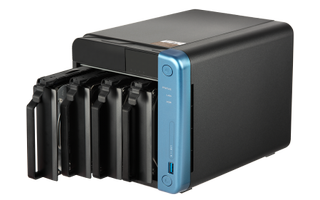
Setup & software
With tool-less drive bays and an easy-to-use setup wizard, getting the TS-453Be connected and configured is super easy. Once up and running, the OS interface is generally clean and simple to navigate, although some of the more in-depth features can take a little digging to find. The NAS supports full drive hardware encryption, and that Celeron CPU provides enough grunt that system performance is mostly unaffected if you do enable this option.
Just as importantly, QNAP has a wide range of apps you can install for free via the built-in app store. Of course, backup options are very comprehensive, and the NAS can link into your cloud storage.
Like most higher-end NAS devices these days, the TS-453Be can run virtual machines. It supports Windows, Linux, Unix and Android machines – making it very easy to run almost any software you desire on the NAS, or experiment with different operating systems to find the one that best suits your needs.
QNAP has also recently launched a new surveillance solution, QVR Pro, for monitoring your home or office. It supports most existing IP cameras and some USB webcams. The ability to connect up to four cameras is included for free, but you need to pay on a per-device basis if you want to use more than this – which mirrors what other NAS-makers, such as Synology, offer with their surveillance-compatible NAS devices, too. It's a setup that's intended to provide enough video surveillance capabilities for home or small office environments.
QNAP also has dedicated smartphone apps for Android and iOS (and even Windows Phone), which make it easy to remotely manage the NAS, or interact with your running software, such as video surveillance. It can also be used to keep a backup of your device, or stream your media. The app's quite straightforward to use, with a fairly comprehensive feature set.
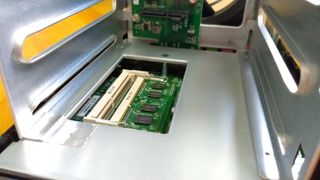

Lindsay is an Australian tech journalist who loves nothing more than rigorous product testing and benchmarking. He is especially passionate about portable computing, doing deep dives into the USB-C specification or getting hands on with energy storage, from power banks to off grid systems. In his spare time Lindsay is usually found tinkering with an endless array of projects or exploring the many waterways around Sydney.
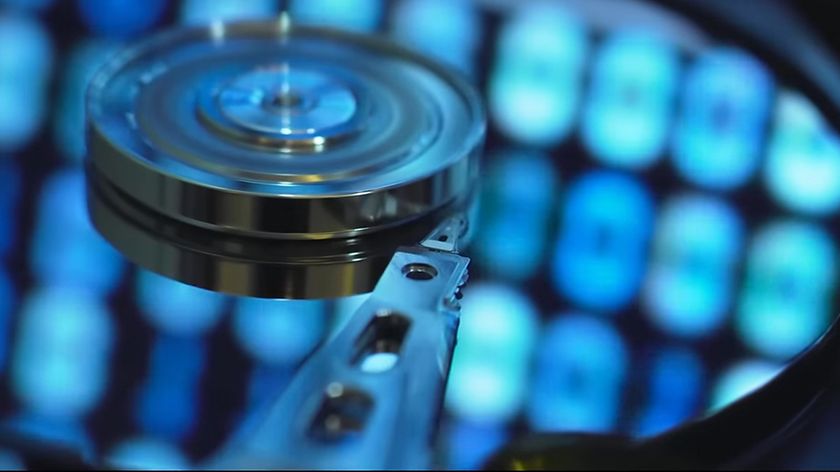
Beyond 100TB, here's how Western Digital is betting on heat dot magnetic recording to reach the storage skies

Man City vs Liverpool live stream: how to watch Premier League online, TV channels, broadcasters

I spent days with this Jiga Power Bank and it has cool features but also some problems that make it hard to carry
Most Popular





